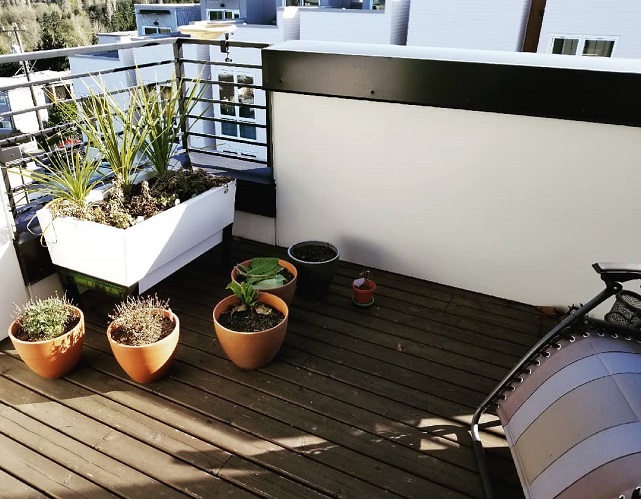It is easy to overlook your plants and find them withering someday, whether due to a busy schedule or while you’re out of town. With the self-watering planters, you may rest easy knowing that your plants are properly looking after themselves. Self-watering planters give an alternate watering strategy that helps the plant in many ways, and not only when you’re away.
Smart Integrated Self-watering System

Sub-irrigation is a technique for watering plants from below rather than above. Self-watering planters employ this technique, which includes a patented sub-irrigation insert that allows the soil to maintain a consistent moisture level at the base of the pot, and thirsty plants’ roots to grow through the insert and directly into the reservoir for continuous access to water and nutrients.
You fill a water storage tank, which is generally located at the bottom of the container, and if there happens to be excess water in the tank, it simply drains out since there is an overflow hole. Because the soil absorbs water from the bottom, as long as the reservoir is kept full, your plants will get a steady amount of hydration from down below.
Some plants, particularly vegetables, may benefit from growing in self-watering pots. Self-watering containers can improve plant health and production by delivering a regular quantity of moisture straight to the roots of plants. Since overwatering plants is one of the most common mistakes gardeners make, with this well-designed self-watering container the plants will get precisely the right quantity of water they need to grow.
Self-watering pots are also ideal if you are on the go and can’t keep up with your plants’ watering demands. They’re also useful if you want to plant some veggies in a container, but due to their position, it makes it difficult to water.
After all, some plants are not adequate for self-watering pots. Succulents, cactus, and other plants that prefer to dry completely between waterings should be avoided for self-watering containers. Many herbs are reported to lose their flavour if maintained in moist soil, while some, like rosemary, like to dry out between waterings. Also, herbs and some flowers, such as nasturtiums, thrive in soil that isn’t rich and well-fed, so investigate your plants’ needs before putting them in self-watering pots.
If you’re convinced by now, you may buy self-watering containers at your local hardware or gardening store, or you can look at the range of veggie planters online.
Why Are Self-watering Planters Ideal for Your Garden?
Self-watering veggie planters can improve the plant’s health and output by supplying a regular quantity of moisture directly to the roots. After you’ve learned how the self-watering planters work, we’d like to point out that these vegetable planter boxes have a slew of additional perks worth mentioning as a result of this genius system.
Encourages Healthy Root Growth

Over-watering and underwatering deprives plants of the water they need to maintain their cellular structure, transport nutrients, and carry out photosynthesis. Self-watering pots can fix these unhealthy practices and improve the plant’s health by supplying just the right quantity of water when it’s needed.
Shallow watering, as experienced gardeners know, can result in shallow root development. Self-watering planters allow you to thoroughly water the container without worrying about root rot. Water rushes to the bottom reservoir, encouraging roots to develop deep in search of moisture. Depending on the plant, strong root systems will create larger stems and branches above for more foliage, blooms, and fruit.
Easily Relocate the Planters- For Indoors and Outdoor Use

There are plenty of houseplants that will flourish in a sunny window indoors. If you have the appropriate circumstances, you can even produce fruits and vegetables. Artificial lighting can help you if your windows don’t have the appropriate type of exposure to allow in enough light. There are a variety of lighting choices available to meet the demands of both blooming and foliage plants. For those with limited mobility or who suffer from allergies, being able to bring the garden indoors is a godsend. With these vegetable planter boxes people may conduct their favourite pastime in the privacy of their own home.
Saves More Water and Fertilizers
Water conservation is a continual problem, especially in arid areas. Self-watering planters only evaporate a portion of the water from the soil, primarily after being watered directly from above. Because the trapped water in the reservoir cannot evaporate due to the deep dirt surrounding it, the jug will also hold the water until it is poured back over the plant. Self-watering pots reduce watering requirements while maintaining a healthy environment for growing even the thirstiest of crops, such as strawberries and small fruit trees.
The reservoir method significantly reduces the amount of water used by self-watering containers. Because the water is held away from the sun and wind, it evaporates more slowly and with less water loss than if you sprayed it on your plants. There is also less risk of fungus and illness since you feed your plants directly via their roots, rather than through their leaves.
The soil nutrients gently diffuse out of the medium with the water molecules as you water a conventional container garden. To keep the soil’s nutrient levels stable, you’ll need to add organic matter on a regular basis. Self-watering containers require typical soil watering, but the closed system keeps the nutrients in the local area, and any water overflow is contained. You just pour the water from the side jug back onto the plant, thereby establishing your own water cycle. Nutrients are not ejected into a plant bed or through drain holes in containers. As a consequence, your plant will thrive as a result of balanced nutrition levels.
Get Busy With Planting

It’s simple to set up your new self-watering pot or planter, but it might look intimidating especially if it’s your first time, So it’s best for you to follow some gardening tips on how to master your new hobby.
After you’ve inserted all of the pieces into the container, fill it with your favourite potting mix; some companies offer soil particularly intended for self-watering pots and planters, but any high-quality soil should suffice. You should avoid using a dry potting mix, and you should wet the soil before placing it in the planter.
Add your chosen plants and pack in the wet soil; just make sure the dirt isn’t too tight; you want the plant to be supported without feeling confined. By watering the plant from the top, all air pockets will be removed, and your plant will now get water from the reservoir.
Allow for the water to flow down through the soil and into the reservoir for a few minutes before adding the required amount of water. You’ll want to make sure the reservoir is entirely filled for the first few days; after that, your plant should have acclimated and you can let the reservoir do its work, with just occasional checks.


